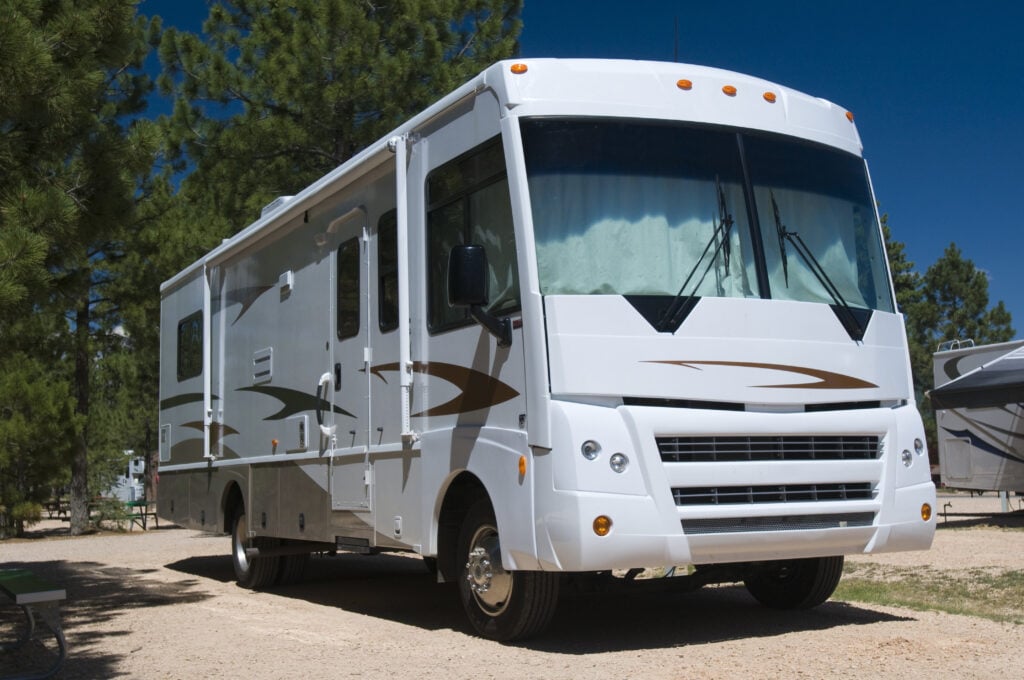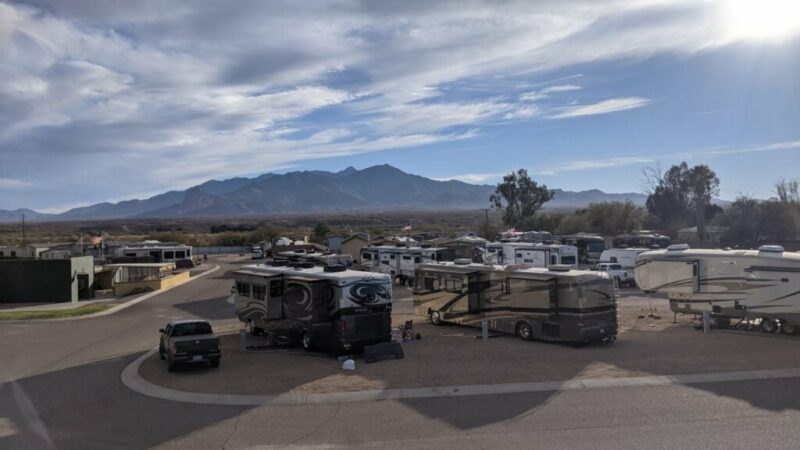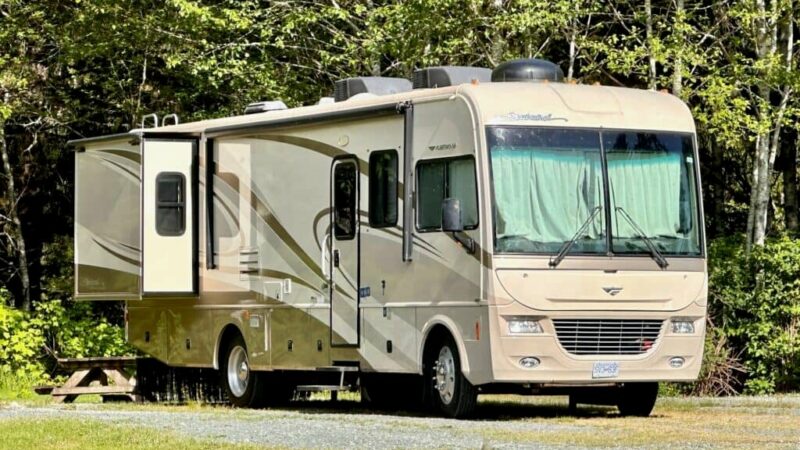Class A RV vs Class C: Which One Is Right For You?
 Source: Shutterstock
Source: ShutterstockShould You Get A Class A Or Class C Motorhome?
If you’re looking for a new RV, you may have narrowed it down to a Class A or Class C motorhome. These are both popular builds that have some similarities. However, they have pros and cons that are worth considering. Of course, the best vehicle is the one that fits your situation.
These motorhomes are the most common ones to find on the market nowadays. Class B motorhomes (aka camper vans) are great for short-term journeys, but they aren’t suitable for large groups or extended camping trips. Before you can find the perfect RV for you, it’s time to compare and contrast Class A and Class C motorhomes.
Class A RV Pros and Cons
Pros:
Large build
First of all, Class A motorhomes are some of the largest on the market. The only other models that come close are fifth wheels. Generally, a Class A motorhome will be at least 30 feet long, and some are closer to 40 feet. This gives you a spacious interior that has room for plenty of furniture, appliances, and open space. If you’re looking for the biggest option, a Class A is what you want.
Multiple slideouts
Because they are so long, these motorhomes can also accommodate a large number of slideouts. Most have at least one or two, but some have four or more. In some cases, there will be a single slideout that runs the entire length of the vehicle. Either way, there are plenty of ways to expand the usable space of these RVs.
Tons of undercarriage storage
If storage is a deciding factor between a Class A or Class C motorhome, choose a Class A RV. In addition to a wealth of interior closets, cabinets, and overhead storage, these vehicles are also equipped with storage lockers under the floor. These can be accessed from the outside, and they’re perfect for storing camping gear and other bulky items that wouldn’t fit inside.
Luxury designs and amenities
Because Class A motorhomes are so large and expensive, they can provide many luxuries and amenities that other RVs can’t. They are usually designed with high-quality furniture and decoration schemes. The appliances are also top of the line. If you’d like to have a luxurious road trip or campout, you can’t beat the comfort of a Class A motorhome.
Cons:
Expensive
One of the biggest drawbacks of a Class A RV is the price. Because they’re so large and luxurious, they cost a pretty penny. You can expect to pay at least $100,000 for a new model and sometimes closer to $250,000. That’s a significant investment that could go toward a cheaper RV or even a house! You need to be very committed to the RV lifestyle for this price to be worthwhile.
Gas guzzlers
Class A motorhomes are notorious gas guzzlers. You’ll pay quite a bit to fill them up, and you’ll need to do this frequently. So in addition to the high initial price, it’s going to remain expensive as long as you drive it.
Bulky
A 30-40 foot vehicle is definitely a different beast compared to a typical car or truck. You may need to take special driving classes to feel comfortable behind the wheel. Even if you’re confident, a Class A motorhome is bulky and slow to respond on the road. It takes some getting used to and will inevitably spark some road frustration from the drivers around you.
Hard to find parking
Parking is also a challenge with one of these RVs. If you travel in urban areas, it’s going to be hard to find a spot that can accommodate you. Some campgrounds also have length limits, so you may be somewhat limited in your options there as well.
Class C Pros and Cons
Pros:
Cheaper
One of the most significant benefits of a Class C motorhome is the lower price. They are smaller than Class A models, so you can definitely find a better price range.
Maneuverability
Generally, Class C RVs are easier to handle than their larger Class A counterparts, making them more suitable for navigating through tight spaces or busy campgrounds.
Maintenance
In many cases, Class C motorhomes are built on standard truck or van chassis. This means parts can be more readily available and mechanics more familiar with their engines, potentially leading to lower maintenance costs.
Easier resale
Due to their lower initial cost and popularity among a wider range of RV enthusiasts, Class C motorhomes can sometimes be easier to resell than specialized or luxury Class A models.
Less intimidating for novices
For those new to RVing, a Class C often feels less intimidating to drive and operate than a large Class A motorhome.
More fuel efficient
Class C motorhomes still require a good amount of fuel, but they are much more efficient than Class A models. They’re also easier to handle on the roads because of their smaller design. You can save money when you buy them and avoid costly refill trips.
Cons:
Smaller than Class A motorhomes
Although there are various vehicle lengths, Class C motorhomes are generally smaller than their Class A counterparts. Even the largest options usually don’t come close. However, if you’re looking for a compromise between a Class A and Class C motorhome, you could always explore Super C RVs. They are essentially extra-large versions of the Class C design.
Less storage space
These vehicles don’t have the spacious undercarriage storage compartments. As such, they are limited in their ability to pack gear on long trips. While you can tow additional storage, it’s not the same as having everything packed into one vehicle.
Not as luxurious
While many Class C motorhomes are still quite luxurious, they might not have the same level of high-end finishes and amenities as a Class A. If you’re looking for the ultimate in RV luxury, Class A is typically where you’ll find it.
Limited slideouts
Compared to Class A motorhomes, Class C RVs generally have fewer slideouts. While this might not be an issue for everyone, if you’re looking to maximize your interior space with multiple slideouts, a Class A motorhome might be a better choice.
Conclusion
When it comes to choosing between a Class A or Class C RV, it really boils down to your personal needs and preferences. Both types of RVs have their unique strengths and weaknesses.
If you’re still having trouble deciding between a Class A and a Class C motorhome, consider the primary uses and needs for your travels:
Choose a Class A if:
- You require a lot of space.
- You plan on using your RV for full-time living.
- Storage space is a priority.
Choose a Class C if:
- You’re not comfortable driving a massive RV.
- You’re looking for a more affordable RV.
- You want a versatile vehicle that can serve multiple purposes.
We hope this guide assists you in your decision-making process. Purchasing a motorhome is a significant commitment, and we hope you find the one that perfectly suits your needs.
No matter what you choose, the most important thing is to ensure it aligns with your lifestyle, travel habits, and budget. Before making a final decision, it might be beneficial to rent each type for a short trip to get a feel for their differences in a real-world setting. This hands-on experience can be invaluable in helping you make an informed decision.
The post Class A RV vs Class C: Which One Is Right For You? appeared first on RV LIFE.






